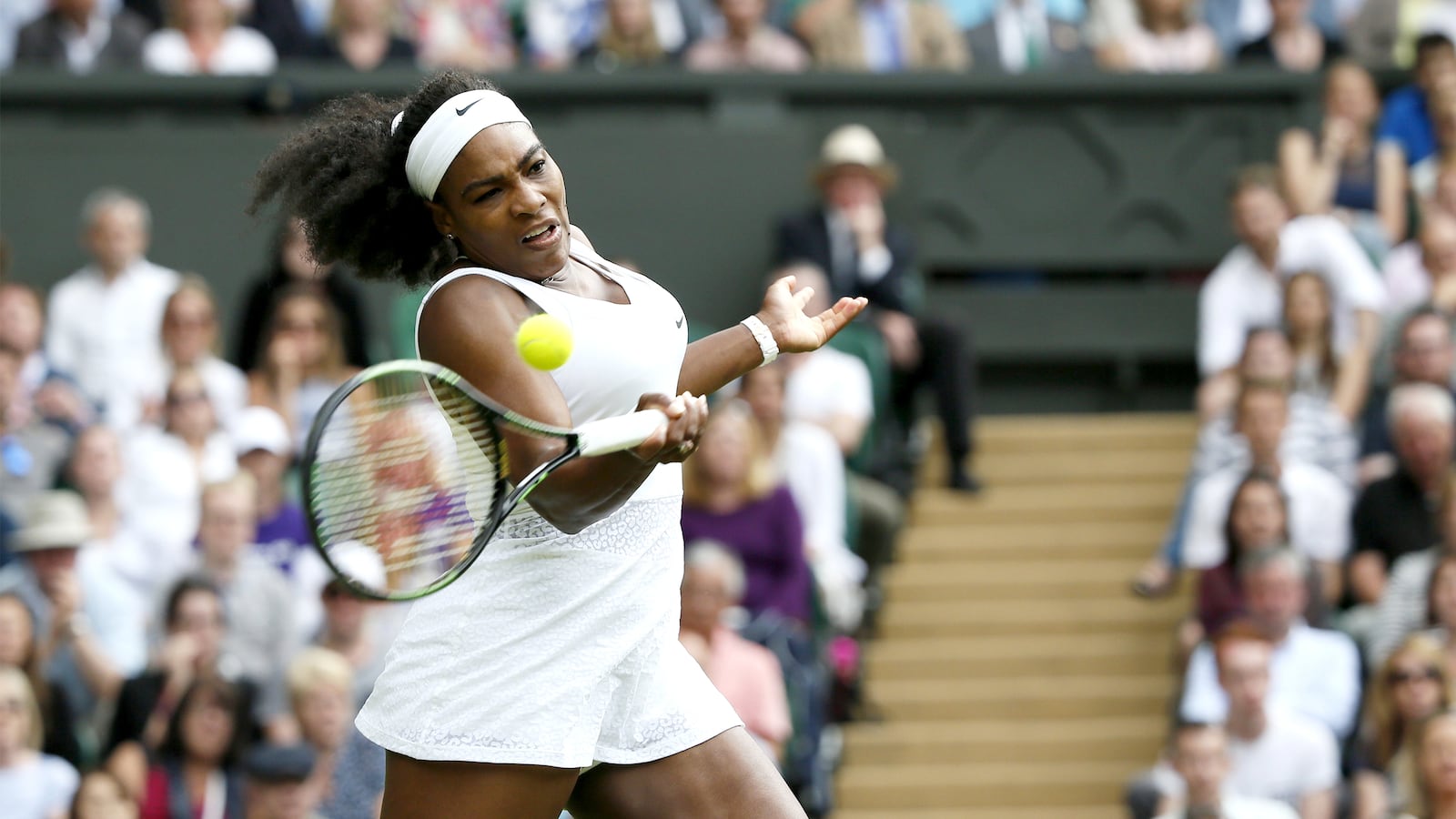Serena Williams is on the cusp of cementing herself as the best, most dominant athlete of her generation, regardless of gender. At the age of 33—ancient by the norms of tennis’s attritive nature—Williams is by far the top-ranked player on the WTA tour and bested 20th ranked Garbine Muguruza in straight sets to claim the 2015 Wimbledon title.
That means she now holds all the Grand Slam titles in tennis and will enter the 2015 U.S. Open with a chance to complete both a calendar year Grand Slam and tie Steffi Graf’s record of 22 Grand Slam titles in the open era.
It’s an awe-inspiring accomplishment in the making, but one that will do little, if anything, to change the fact that Serena Williams’s legacy will be decided in the context of a society that has institutionally oppressed black women. This institutional oppression manifests itself across a broad spectrum of data.
The U.S. Bureau of Labor Statistics reports that black women earn $100 less per week than white women. Black women have a median wealth of $100 compared to a median wealth of $45,400 for white women, according to the Center for Global Policy Solutions. A study by the Sentencing Project finds that black women have a 1 in 19 lifetime likelihood of imprisonment, while the same measure stands at 1 in 118 for white women. There’s even a gap in life expectancy between black and white women. The data we have all points to the conclusion that black women are institutionally oppressed and disadvantaged.
And one would need only to glance at the history of bankrupt accusations and bullshit levied against Williams for proof of how that oppression and its associated stereotypes play out in media. There was the time tennis great Chris Evert wrote an open letter to a then-24-year-old Williams chiding her for a supposed lack of commitment while Williams was battling through injuries.
There was also the time another tennis great, John McEnroe, baselessly accused Williams of allowing her father, Richard Williams, to fix matches between her and her sister, Venus.
Then there was the time Jason Whitlock (who is black, himself) wrote of his sexual attraction to Williams while comparing her to various animals, equating her to Paris Hilton, and repeatedly implying she was eating too much to ever topple the Grand Slam record she might tie this weekend. Whitlock was also one of many who criticized Williams for busting out a crip walk after winning Olympic gold, the underlying accusation being that Williams had somehow disrespected a hallowed institution by performing a brief celebratory dance.
There are plenty of other examples to cite, but you get the point: The mainstream depiction of Williams often hinges on depicting her as amoral, lazy, disrespectful, and animalistic.
Clearly, this isn’t just another case of a big-name athlete making for an easy target. No, because Serena Williams is a wildly successful black woman in a white-dominated sport, she occupies a fraught space both within the sport itself and the society actively informing our perceptions.
“American racist tropes tend to be constructed in ways that render black women one-dimensional,” says Mikki Kendall, a writer and cofounder of HoodFeminism.com. “So when Serena refuses to be the kindly self-effacing Mammy, the over-sexed Jezebel, or the harridan Sapphire, media organizations don’t know how to handle her. She is beautiful, strong, successful, and presents a model of femininity that is very familiar to black American communities, even if it is the antithesis of white expectations.”
The idea that Williams transgresses against feminine beauty norms, particularly within the context of tennis, is readily proven. After all, the common mental image of a women’s tennis player is white and lithe, in perfect harmony with Western ideals of feminine beauty, while Williams is black and built like a powerlifter. She is an unprecedented affront to our collective notion of the beautiful female athlete.
The cost of this transgression can be seen in Whitlock’s creepy sexualization and demonization of Williams’s body, a self-contradictory tactic that betrays a deep discomfort with Williams’s expression of femininity. Another more readily measured cost can be seen in the fact that Maria Sharapova—the 4th-ranked player in the world—is the highest paid athlete not just in all of women’s tennis, but in all of women’s sports. Naturally, Sharapova is tall, blond, and slender, a paean to the Western beauty ideals that net her endless endorsement opportunities regardless of her on-court performance.
Meanwhile, despite quintupling Sharapova’s prize money and holding an 18-2 career record against her—including 17 consecutive wins head-to-head—Williams makes half of what her pseudo-rival manages in endorsements. The racist notions of feminine beauty playing out here are as subtle as a forehand to the throat.
Further, because Williams’s body is itself so unfamiliar in a mainstream Western context, there is the sense that, like so many other black athletes, she has been gifted an unfair genetic advantage. This serves to obfuscate the fact that all elite athletes have some natural advantage of some sort while also minimizing the sacrifice and dedication it takes to become an elite athlete regardless of natural advantage.
In Williams’s case, not even her life story—one that aligns perfectly with the narrative of the American dream and has seen her represent the U.S. on some of sports’ most mythic stages—grants her the humanity she is so routinely denied.
“It’s weird, here you have Serena who won an Olympic gold medal representing the U.S. and has this rags-to-riches story, but it hasn’t helped her in the way it has helped prior black female athletes,” says Lou Moore, a history professor at Grand Valley State University who specializes in U.S., African-American, and sports history.
“Especially in the post-Civil Rights era, black female athletes representing the U.S. have been held up as examples of our progress,” he says. “But in Serena’s case, dominating a traditionally white, middle-class sport hits on American racism and sexism in such a way that it overrides the usual narrative.”
In that sense, it’s surprising that Williams’s story of picking up a tennis racquet in Compton and ending up the greatest women’s tennis player of all time hasn’t been turned into a homily on Americana.
“If Serena were smaller, lighter, and less connected to her roots she would probably be more popular,” says Kendall. “But racism means that many Americans look at her refusal to be ashamed of coming from the inner city, her rejection of European beauty aesthetics, and her spectacular record and see a negro that doesn’t know her place.”
In the strictest sense, Williams indeed does not know her place. She is a black woman dominating a white sport and that triggers the fear essential to the efficacy of racism and sexism. It is no secret that white men have owned most every sector of Western society for centuries now, and any progress made on that front has come with, at minimum, the overt vilification of those leading the fight.
And while Williams’s career will always be inextricably linked to the racism and sexism weaponized against her, there is a comforting fact at the core of this discussion: Serena Williams has already won. She has the trophies to prove it.





